ACTUALLY, ACALA
First look on board Cantiere delle Marche’s 43m custom explorer
A modest-sized explorer has been turning heads and firing imaginations. Caroline White finds out exactly what it is that makes this 43-metre Cantiere delle Marche so special
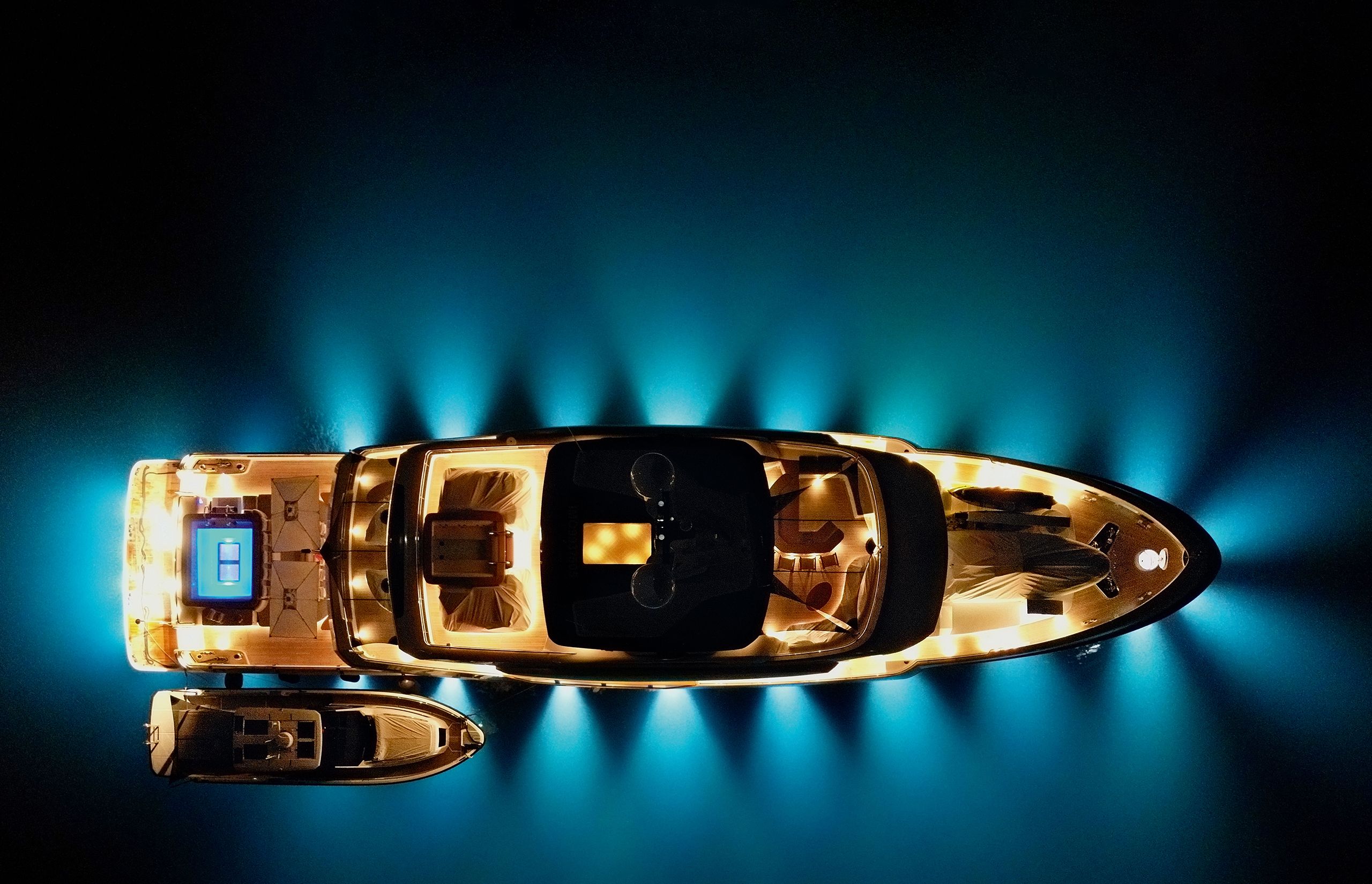
The hottest debut at the Monaco Yacht Show is usually a very big boat. Helter-skelter panes of structural glass glinting across Port Hercule, extravagant wonders hidden in ultra-private depths – an underwater room, or a full-size padel tennis court. Superyacht superfans trail round to the long, isolated arm of Quai Rainier III, where these monolithic hulls moor side-on, snapping Instagram pics while security guards peek sleepily from beneath their sunglasses.
This year, however, the phrase echoed at press conferences and cocktail parties, as people discussed their favourite yachts, was “Actually, Acala”. “Actually” because this Cantiere delle Marche (CdM) is a relatively modest 43 metres and lay sandwiched inconspicuously between two other yachts in the main drag of the show. But anyone who’s been on board will tell you she’s something rather special: a true explorer on a discreet scale, with a layout that is ruthlessly logical and utterly unconventional, and a low-key interior design of superlative natural beauty. If the usual Monaco grand dame is a proliferation of great design, Acala is a distillation of it.
“Building big doesn’t mean anything. This boat is the [apex] of the maturity of a client who has owned the Lürssen 78 metre [TV, ex-Madsummer], and whose father was cruising with two 50-metre Feadships,” says Vasco Buonpensiere, CEO of CdM. “Blohm+Voss built one of the most iconic superyachts ever, Eco [for him],” he says, referring to the 1991, 74.5 metre Martin Francis yacht that has become a pin-up for generations of superyacht designers. Or as Acala’s exterior designer Horacio Bozzo rather understates it, “he grew up on boats”.
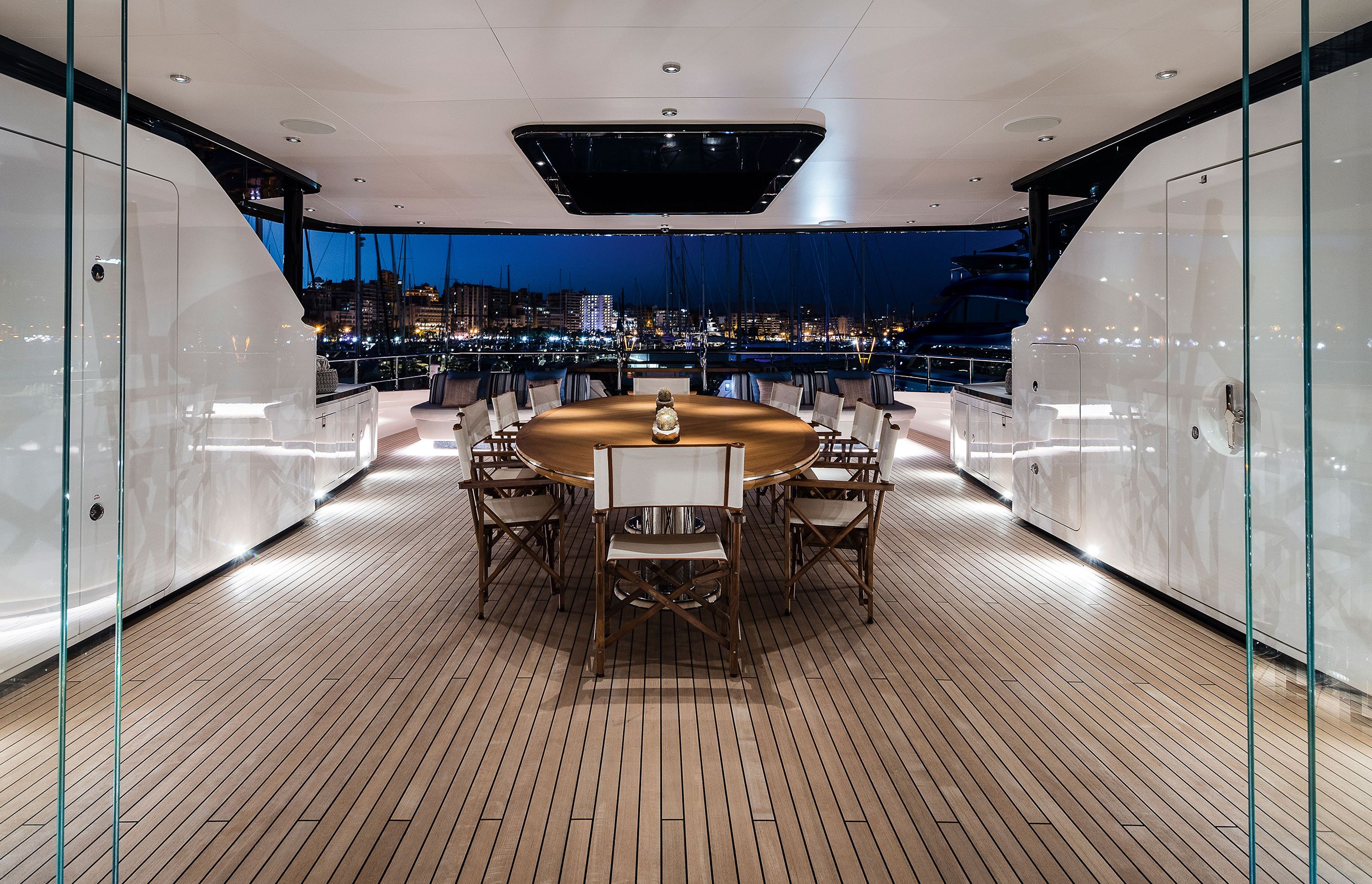
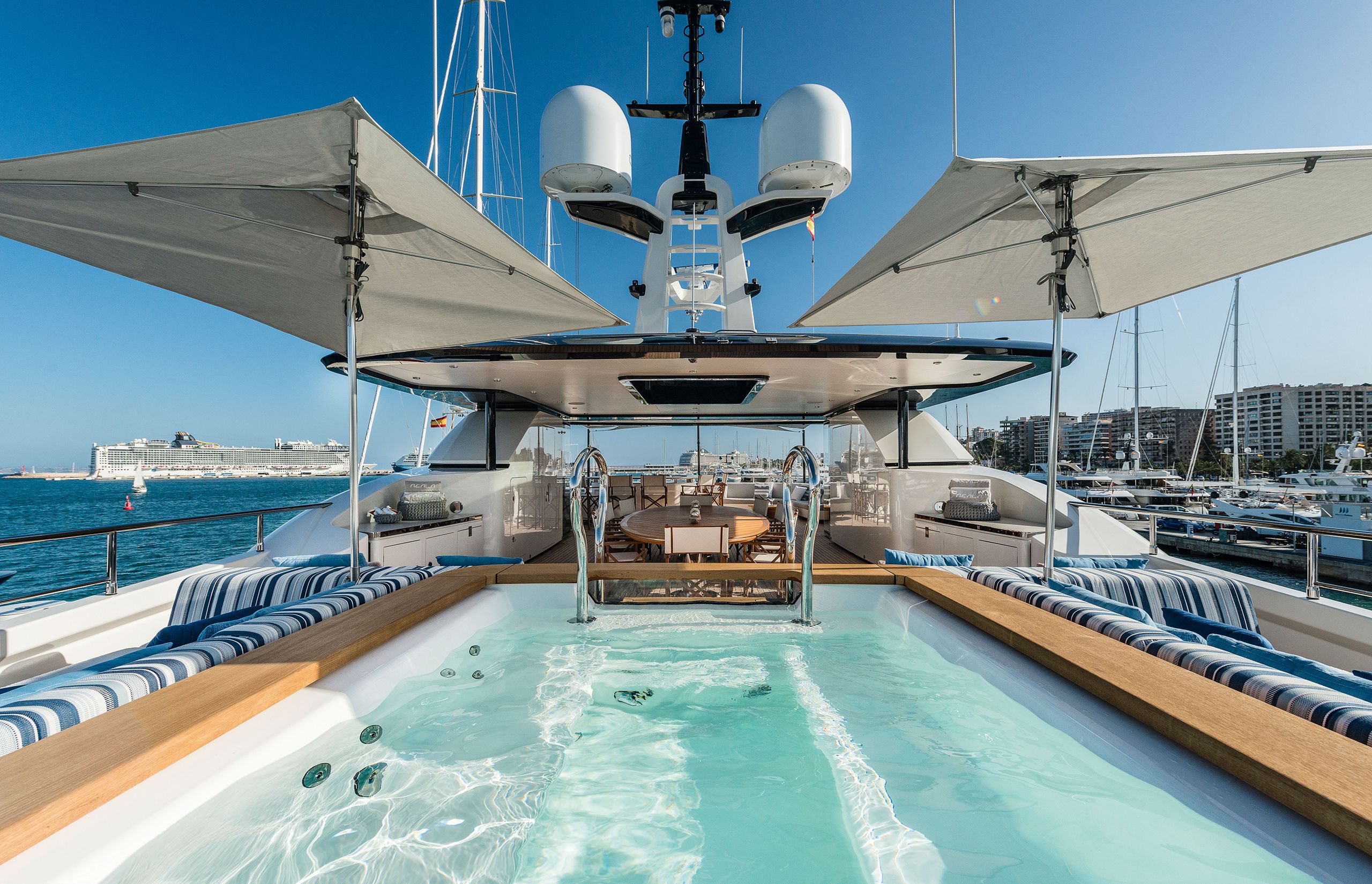
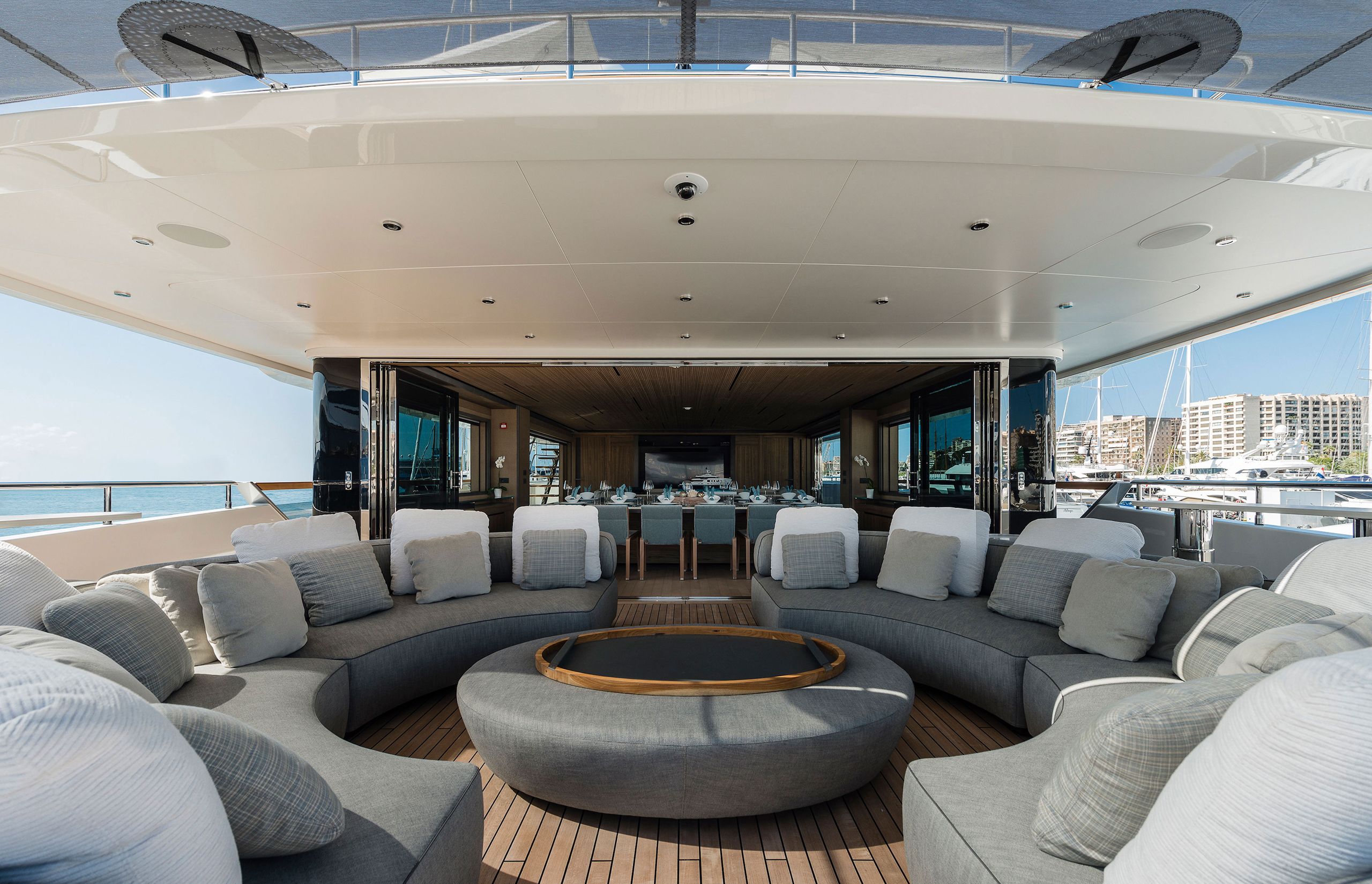
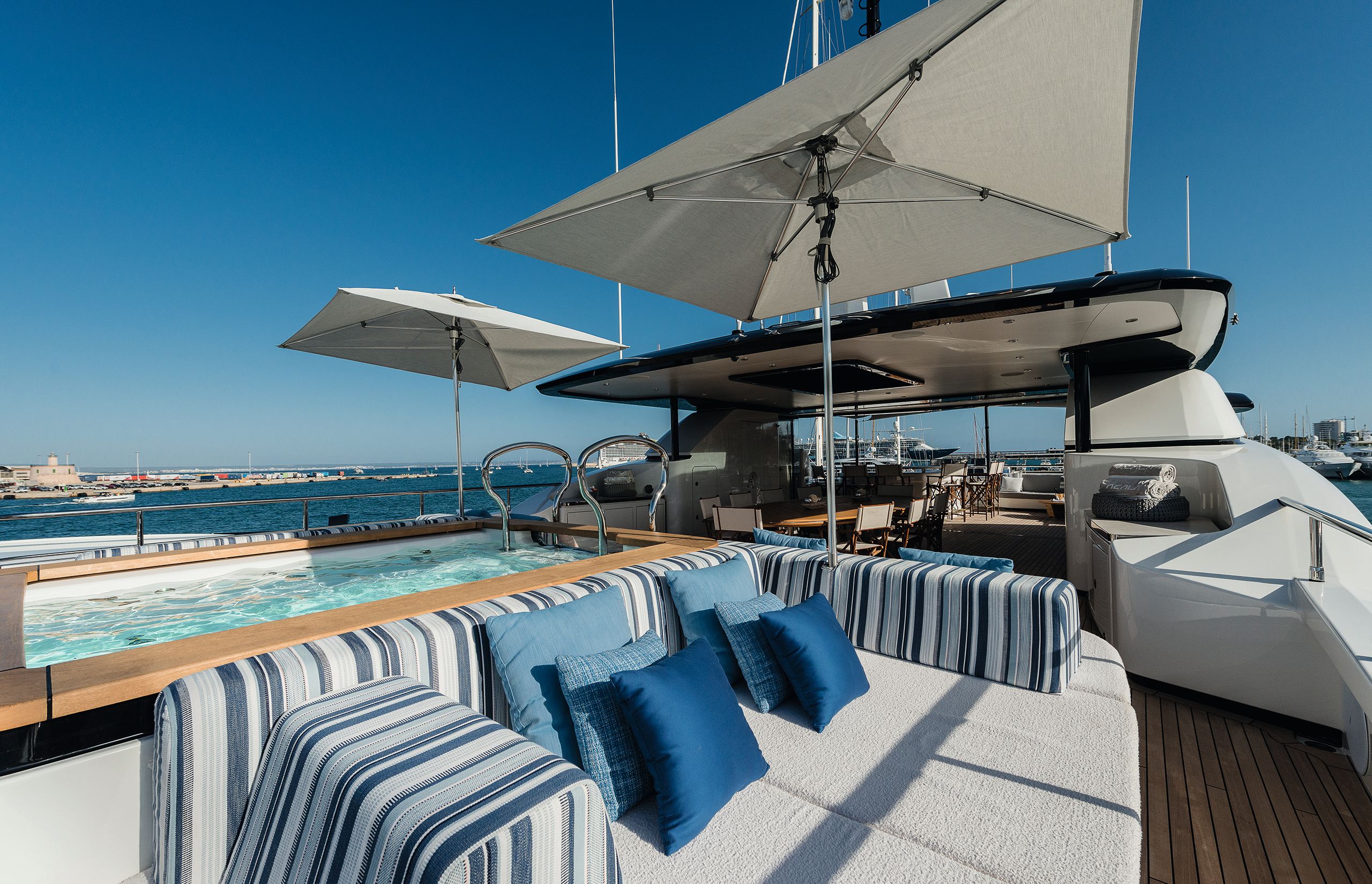

LEONARDO ANDREONI
LEONARDO ANDREONI

LEONARDO ANDREONI
LEONARDO ANDREONI

LEONARDO ANDREONI
LEONARDO ANDREONI

LEONARDO ANDREONI
LEONARDO ANDREONI
Acala’s sundeck is a scaled-down version of the deck on the owners’ larger Lürssen. It hosts a range of informal entertaining options and a spa pool (bottom and top right) as well as a formal dining area (top left). Her upper saloon (bottom left) takes the role of the main saloon, with a dining table. Informal outside seating and full-height windows add to the feeling of space
Acala won the Displacement Motor Yachts 499GT and below, 40m to 44.9m, category at the World Superyacht Awards 2023
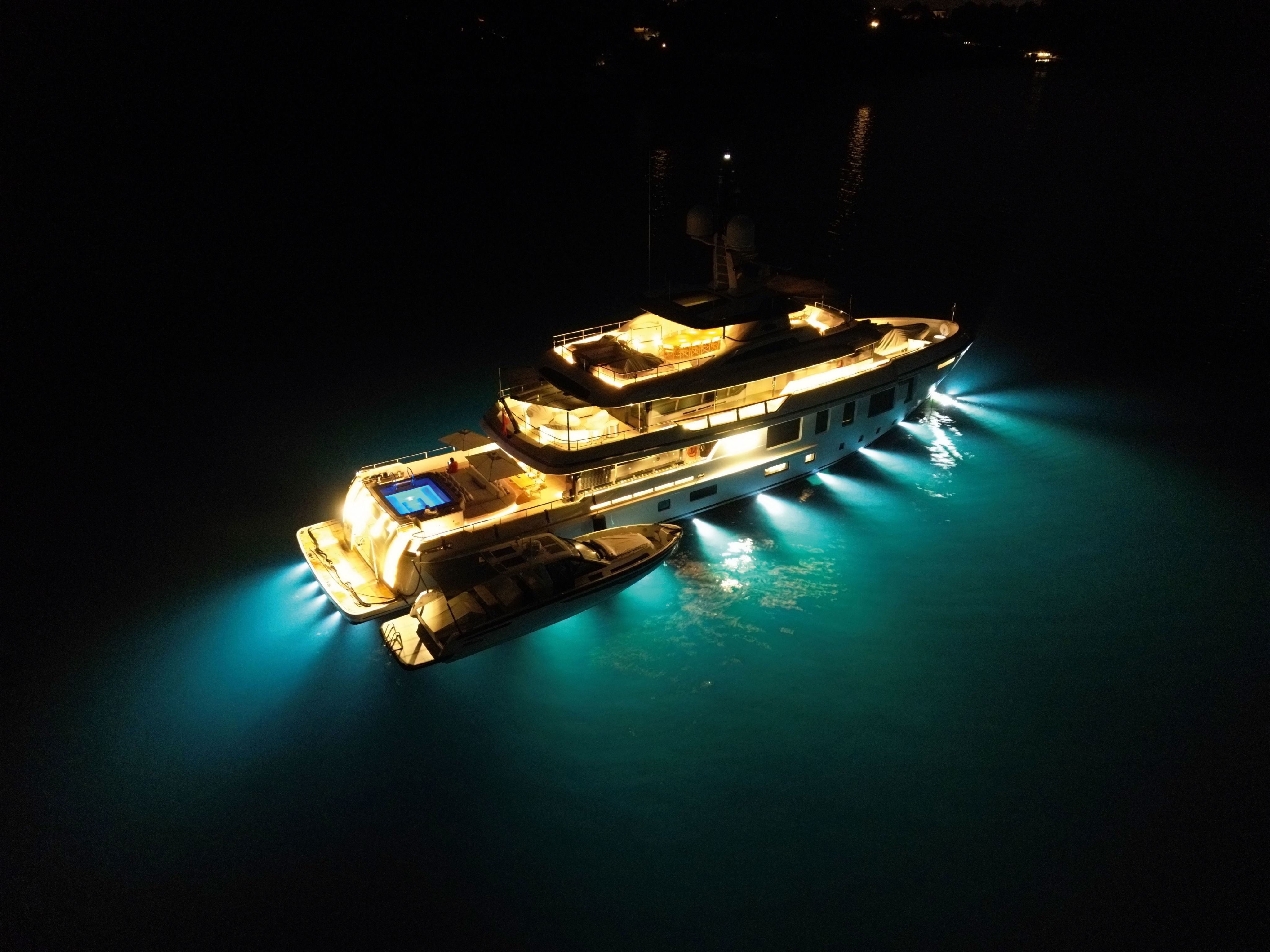
The owner had already built a 31-metre Darwin 102 explorer with CdM. “He still had the 78-metre [at the time] and he wanted to have a family boat to go diving just with a close number of friends,” says Buonpensiere. “It was what I call a purpose boat.”
Having got a taste for cruising this way, he sold the bigger yacht and commissioned CdM to build the 499GT boat that would become Acala. It makes sense: what’s the point of visiting exotic destinations if your yacht’s so big, you can’t get anywhere near the coast?
The design team the owner assembled included Bozzo, an experienced naval architect who had penned a 35-metre explorer concept in 2016 that appealed to him. “This boat is completely different, but there was something [in that design] that caught his attention,” says Bozzo. He had a hand in every aspect of the design from concept to interior layout, except the interior design – that was down to Mexican designer Simón Hamui, who had penned a house interior for the owner, as well as a Feadship and his previous CdM.
Hamui may be an unfamiliar name among Europeans, but as Buonpensiere puts it, “the great majority of [Mexican] clients I meet, they’ve [done] at least one office or the house with him”.
An industrial designer by training, Hamui studied in New York in the 1980s, before returning home to Mexico to start his business there. In the early days, his carpenter worked out of a tiny shack in Mexico City; now, he has about 200 people working for him, with in-house metal and stone shops, although wood remains the “core material we work with,” Hamui says – and the one that defines Acala’s interior.
Running through every facet of the yacht’s design, inside and out, was the owners’ crystal-clear vision. “They were very keen and very, very careful, with tremendous experience of how boats live and operate and what they should encompass and what they should not,” he says. “The owner is a real explorer. He sails all the boats, including ours, in places that nobody else will go to,” says Buonpensiere. “He has spent time in Papua New Guinea, places like that.”
Appropriately, CdM’s specialism is modest to mid-size explorers. And rather like Acala’s owner, this young Italian yard goes against the grain – while many are building standard white yachts with the aesthetic details of tough explorers (see reverse windows) to fit current fashions, CdM now frequently builds explorers that appear to be conventional white yachts (as well as more traditional-looking expedition boats). Its RJ range of designs looks at home in the South of France, but the first hull has cruised happily in 78 knots of wind.
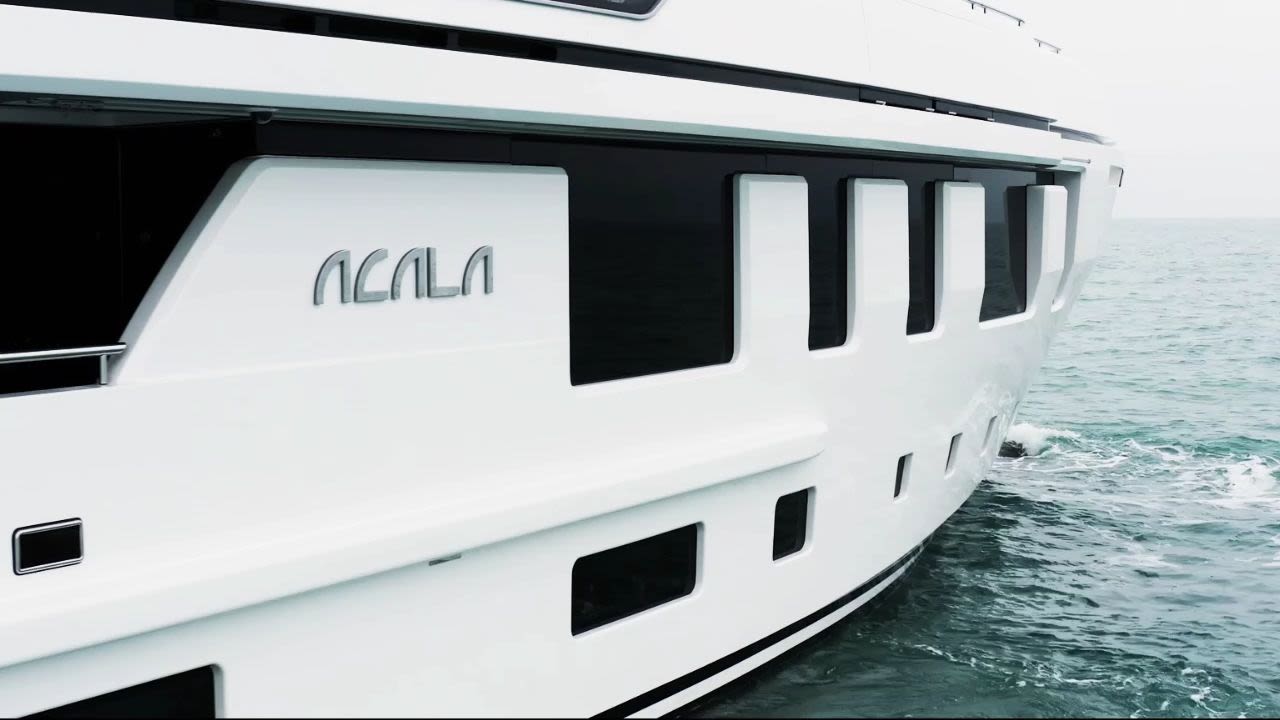
Acala’s exterior design “captures the soul of an explorer vessel with the elegance of a yacht”, says Bozzo, with a gently raked bow, but few overtly expedition features. Of particular appeal are the vast cabin windows on the main deck, whose uppermost mullions appear almost invisible from the outside, and which transform the interior spaces into viewing rooms for the far-flung destinations the yacht will visit. Considering the generous beam (8.6 metres) and all deck heights being a minimum of 2.2 metres, he has created an admirably balanced exterior profile.
The yacht has an expedition-worthy range of 8,000 nautical miles at 9.5 knots, but there’s also a focus on durability and reliability. Take a detail like the doors of storage lockers on the main aft deck: thick CNC’d aluminium with a heavy-duty seal. Or the cabin doors: 44 kilograms, with pistons to prevent slamming, automatic seals to limit noise and four hinges rather than three, “so they don’t bend over time, because a boat like this, which is going to cruise whatever the weather, it’s going to move,” say Buonpensiere.
The engine room is also a model of pragmatism, with ample space to access machinery, a control room (not standard on a yacht this size) and access down to a tunnel – of standing height – that runs the length of the hull, letting crew get easily to stabilisers and piping, as well as store luggage.
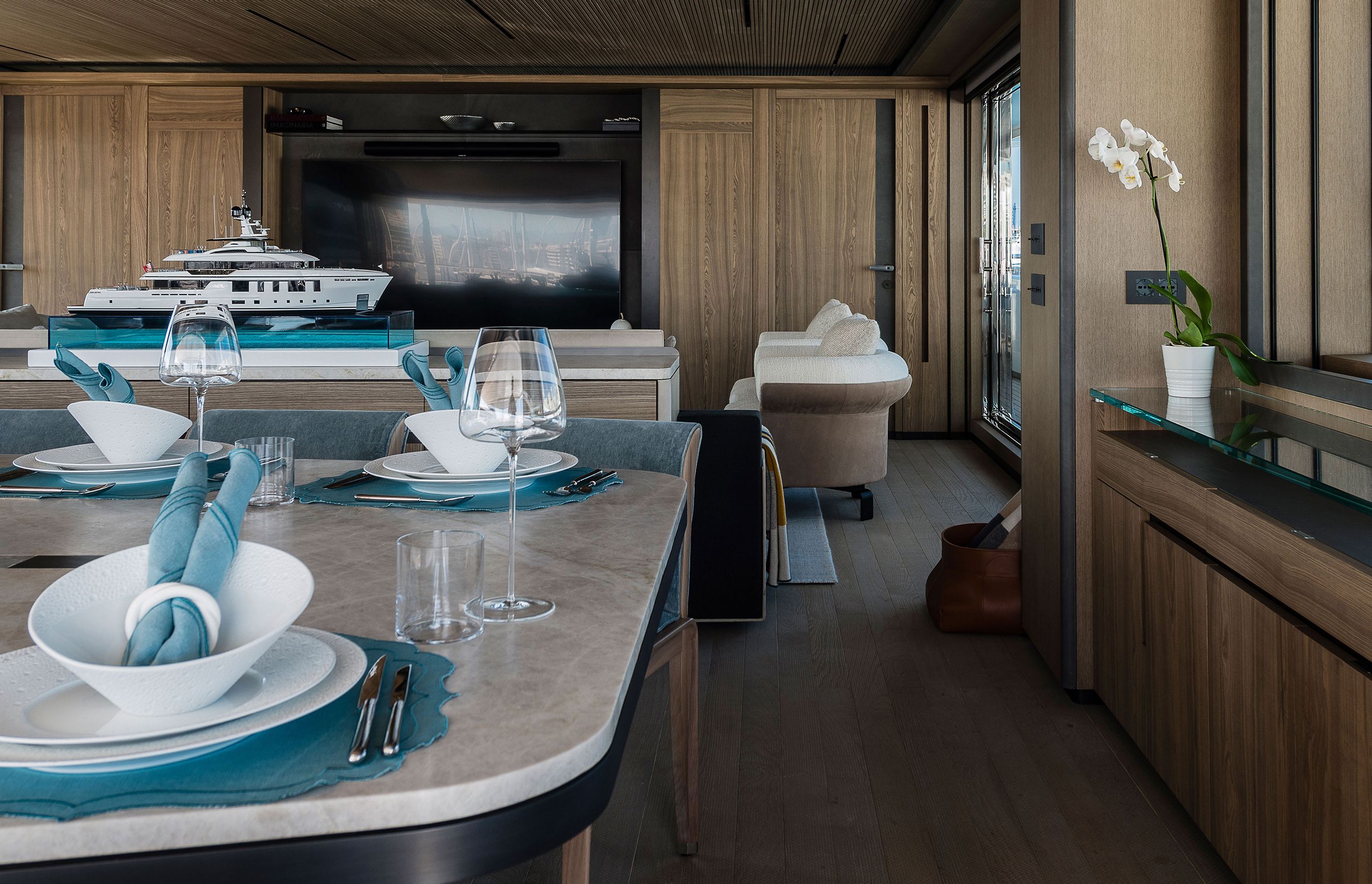
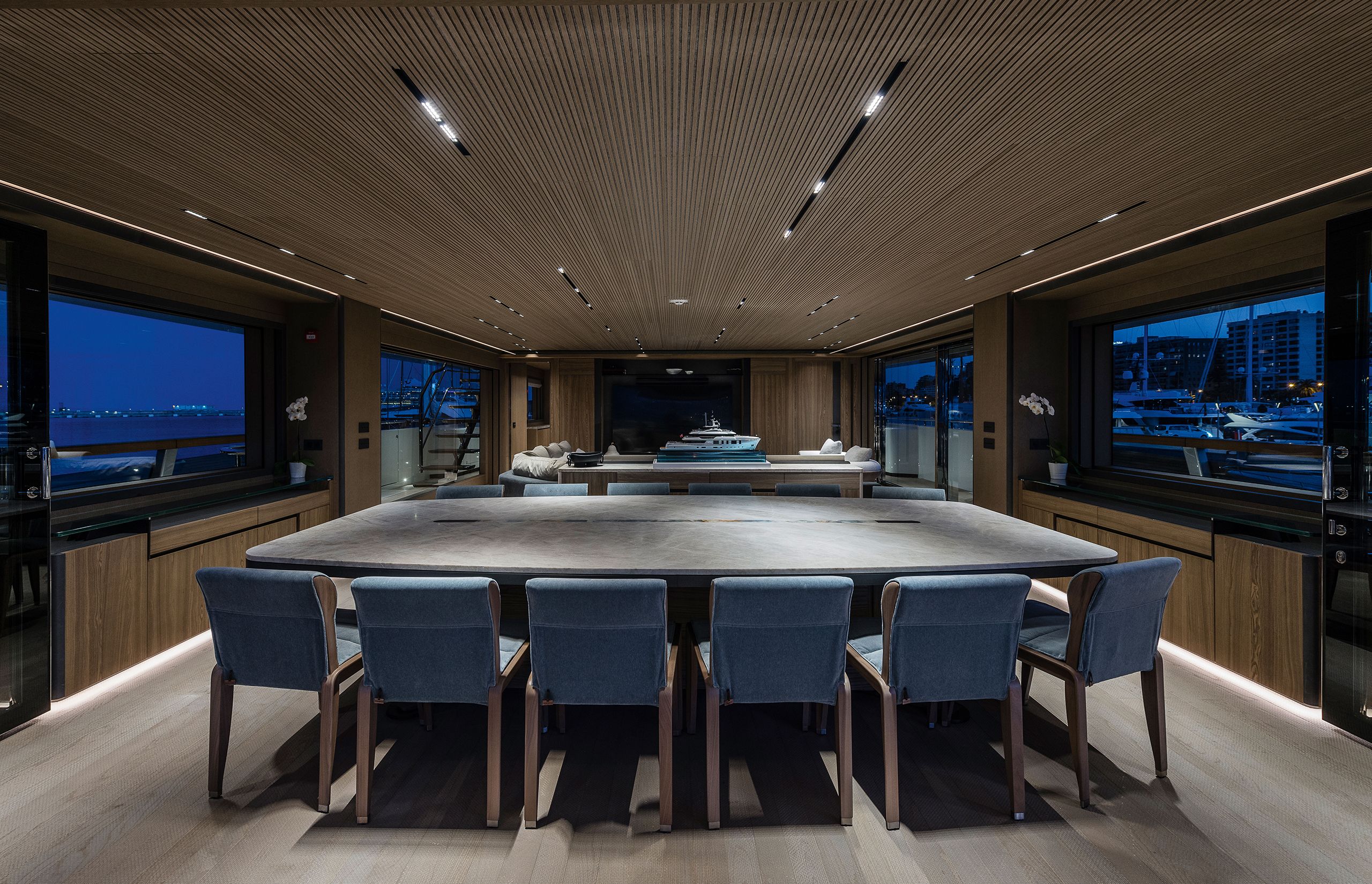
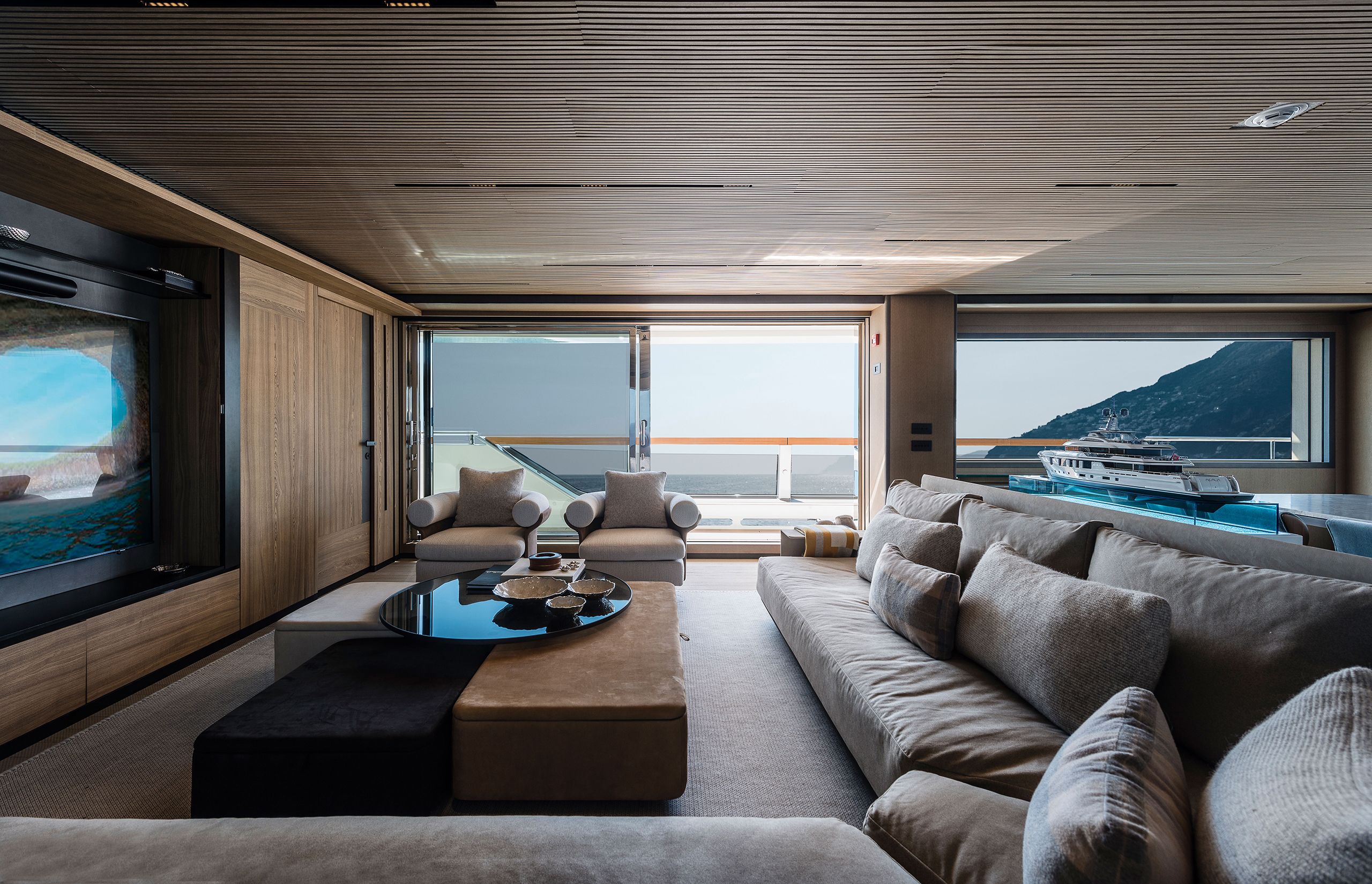
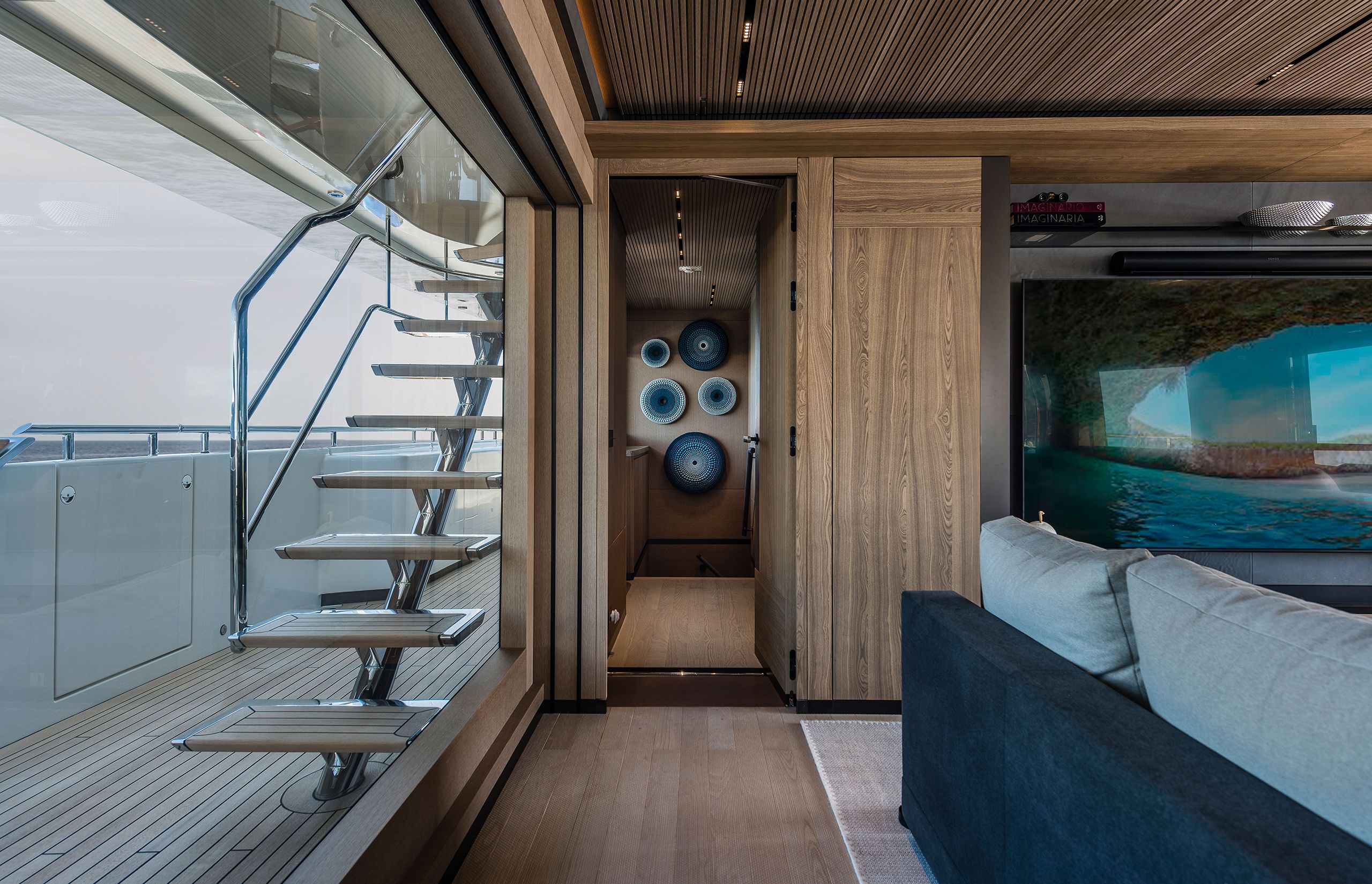

LEONARDO ANDREONI
LEONARDO ANDREONI

LEONARDO ANDREONI
LEONARDO ANDREONI

LEONARDO ANDREONI
LEONARDO ANDREONI

LEONARDO ANDREONI
LEONARDO ANDREONI
The upper saloon is where the owners really spend their time, whether it’s gathering around the television (bottom left) or around the dining table (top). Wide passageways add to the impression of size (below right)
There’s also a nitrox compressor in the engine room, an important bit of kit for an important space that lies aft: the beach club dive store. Like the nitrox, the skylights overhead hint that this area is anything but an afterthought. There’s every bit of kit imaginable, as well as a neat row of dive cylinders hanging on the wall reminiscent of, as Buonpensiere puts it, “an art installation”.
Up on the main deck, the owners’ clear vision of how they would use the yacht is again in evidence. “They decided, okay let’s get everything out and make our ideal boat with everything we want, and how we feel it has to be done,” says Hamui. The “everything” that was going out included a traditional main saloon. Instead, here lies a small, snug room with desks for video editing to starboard and a cosy round of sofas to port.
Forward of this space, where you might expect to find a grand lobby, followed by a grander owner’s cabin, you instead find a low-key staircase and four guest cabins ranging off a corridor, including the master. The latter is only marginally more luxurious than the rest, with a walk-in wardrobe-cum-bathroom forward. The owner saw no reason to devote acres of real estate to a master when he and his wife only sleep there. “He preferred just to have one more friend or one more family [member] than a bigger cabin,” says Bozzo. Two more guest cabins downstairs bring the total to six.
The upper saloon “is where they really spend their time,” says Buonpensiere. This light-filled space takes up the role of a main saloon, with cosy seating forward and a huge dining table that sits on the cusp of the aft deck. Full-height doors entirely open the space aft, with more to port and starboard, where vast side passageways perform the clever trick of suggesting a far larger yacht. They also become, with the assistance of a coffee table and chairs, balconies. “That’s also why we put the glass [panels in the bulwarks], so you can see through,” says Buonpensiere.
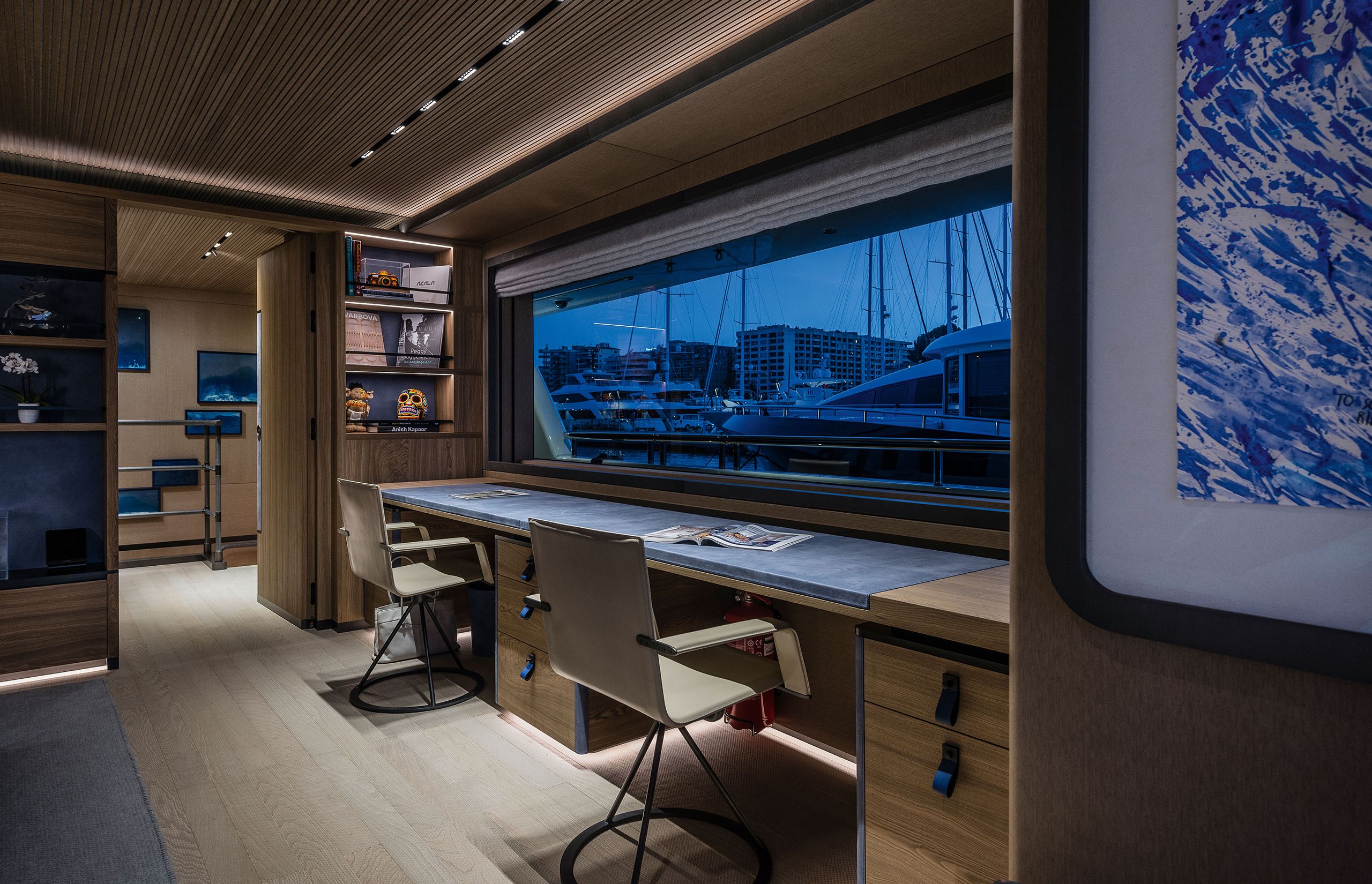
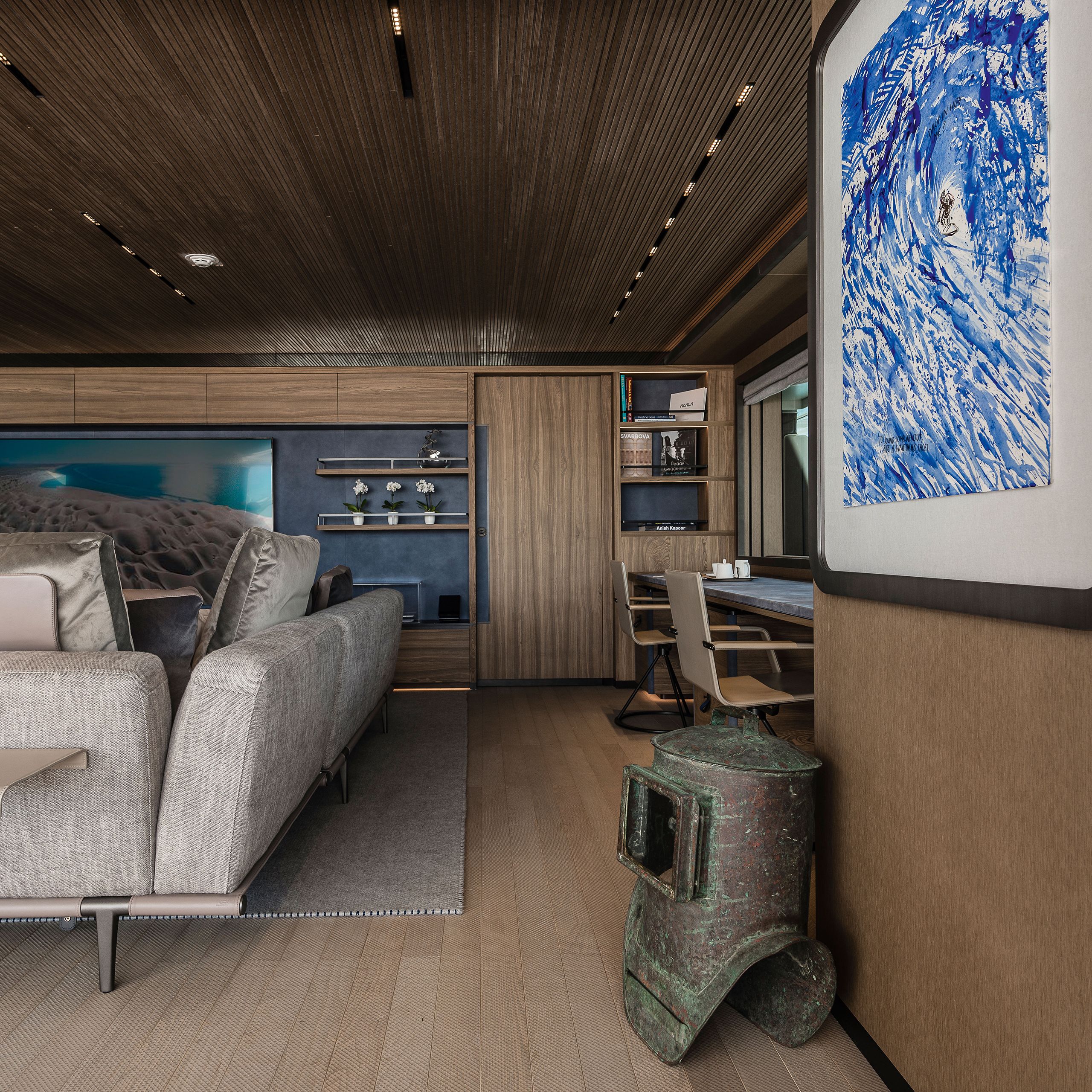
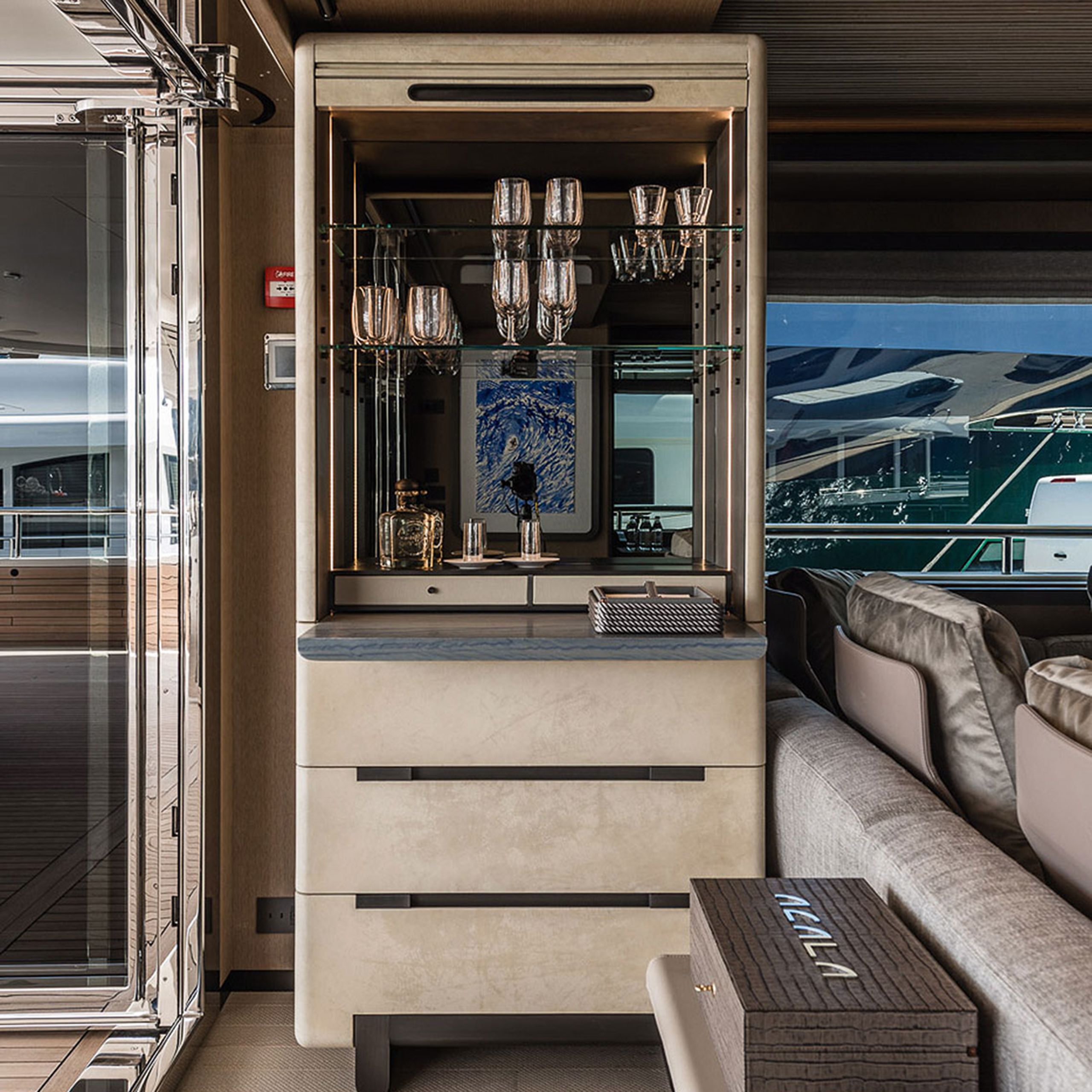
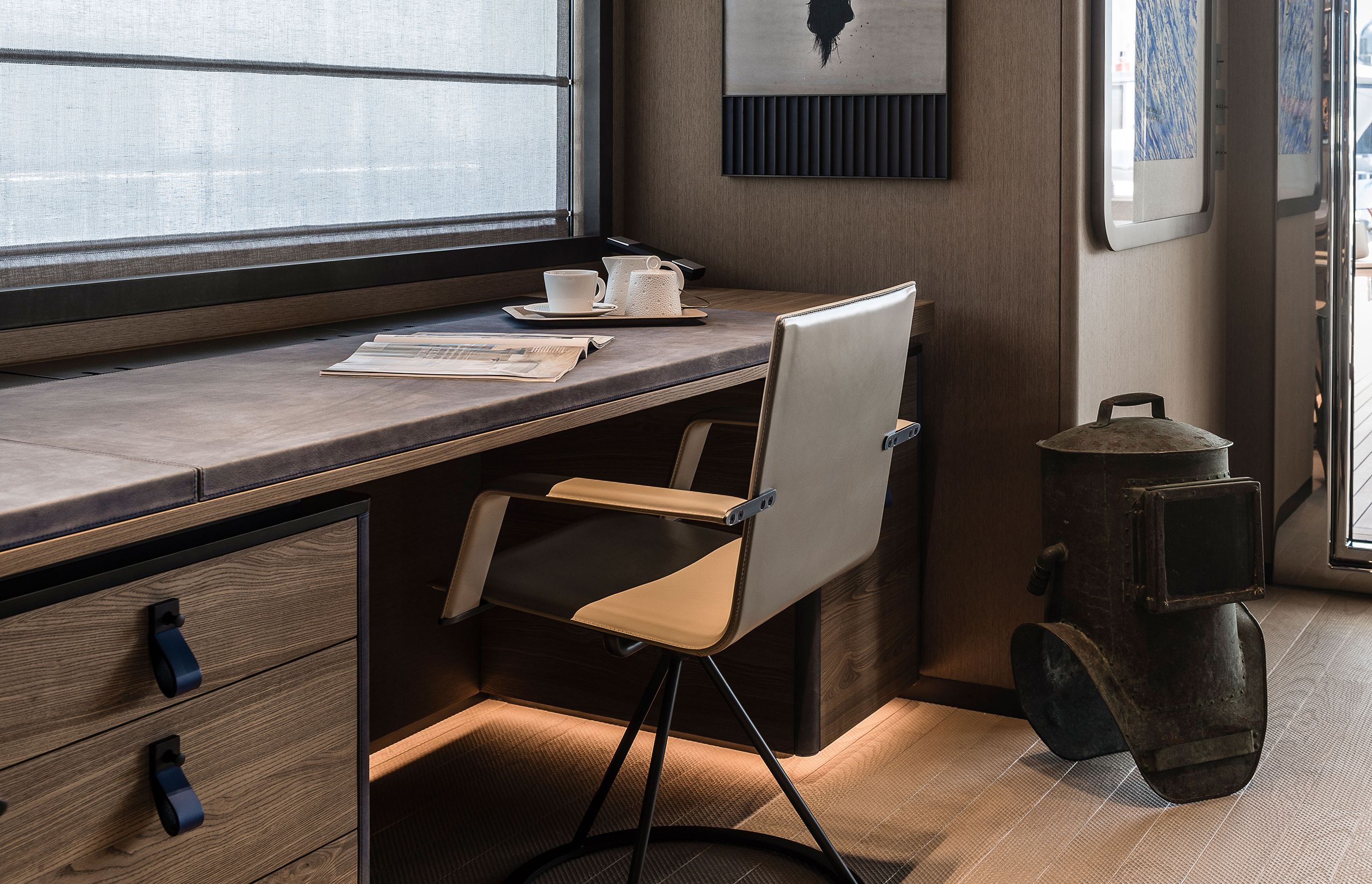
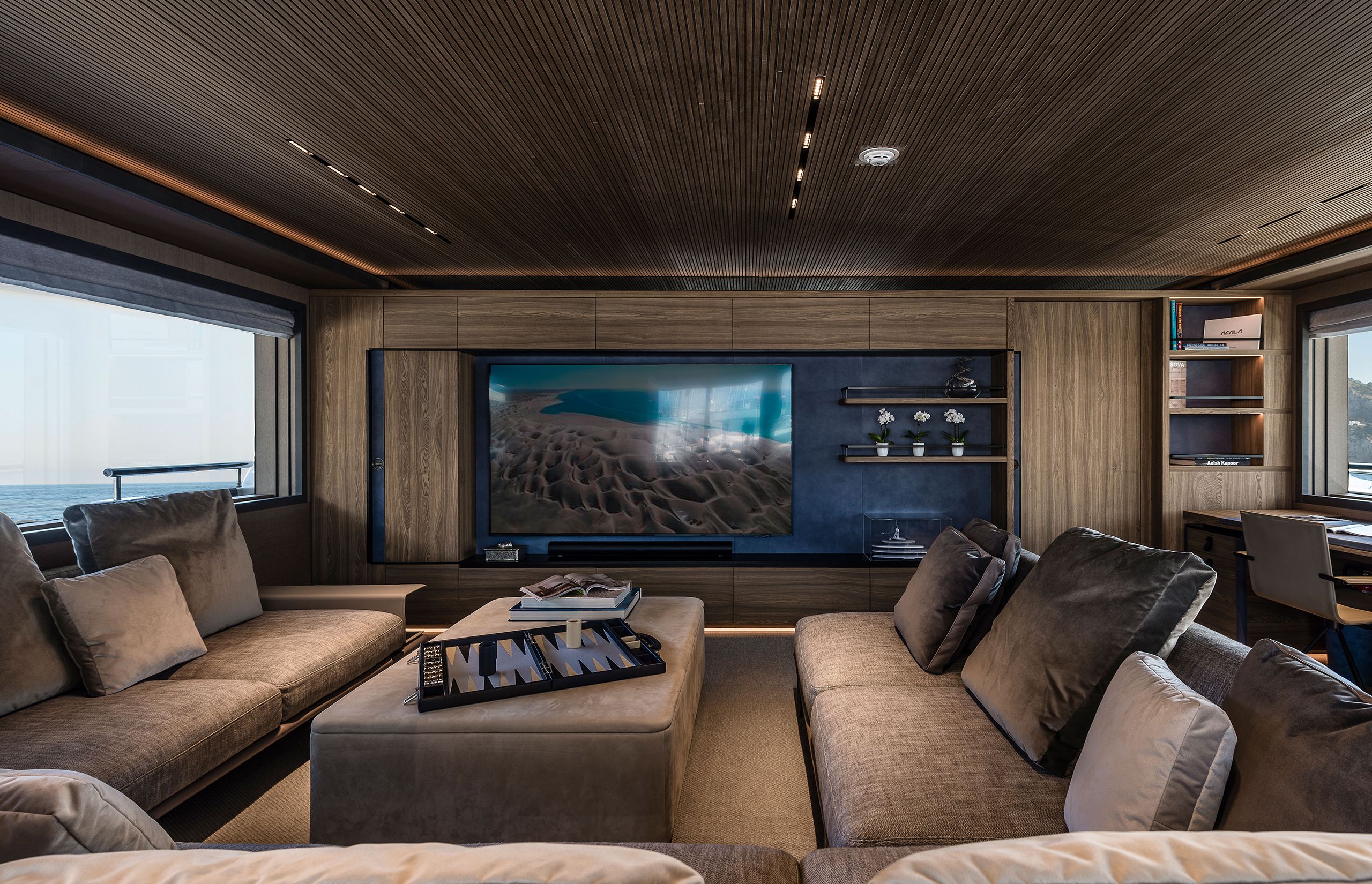

LEONARDO ANDREONI
LEONARDO ANDREONI

LEONARDO ANDREONI
LEONARDO ANDREONI

LEONARDO ANDREONI
LEONARDO ANDREONI

LEONARDO ANDREONI
LEONARDO ANDREONI

LEONARDO ANDREONI
LEONARDO ANDREONI
A muted, natural palette based around wood, including ash, oak and eucalyptus, is enhanced by tactile details, such as soft leather inserts and pulls on custom-designed furniture by Simón Hamui’s studio
A deck up, you have a sundeck, which the owner specced as a scaled-down version of the sundeck on his Lürssen, with a spa pool, dining, bar and sliding glass windbreaker.
To sum up, the aft portion of the main deck, plus the dive store below, becomes an interconnected, ocean and dive focused space. The upper saloon above is the main living space, while the sundeck offers a laid-back outdoor area. Curtailing the main saloon means there’s ample space for guest and master cabins. “They figured out that if you’ve got a lot of kids and a lot of adults, it makes sense to have that versatility. Kids want to watch something, the adults want to do something else,” says Hamui. “They can be divided, they can [be] together.”
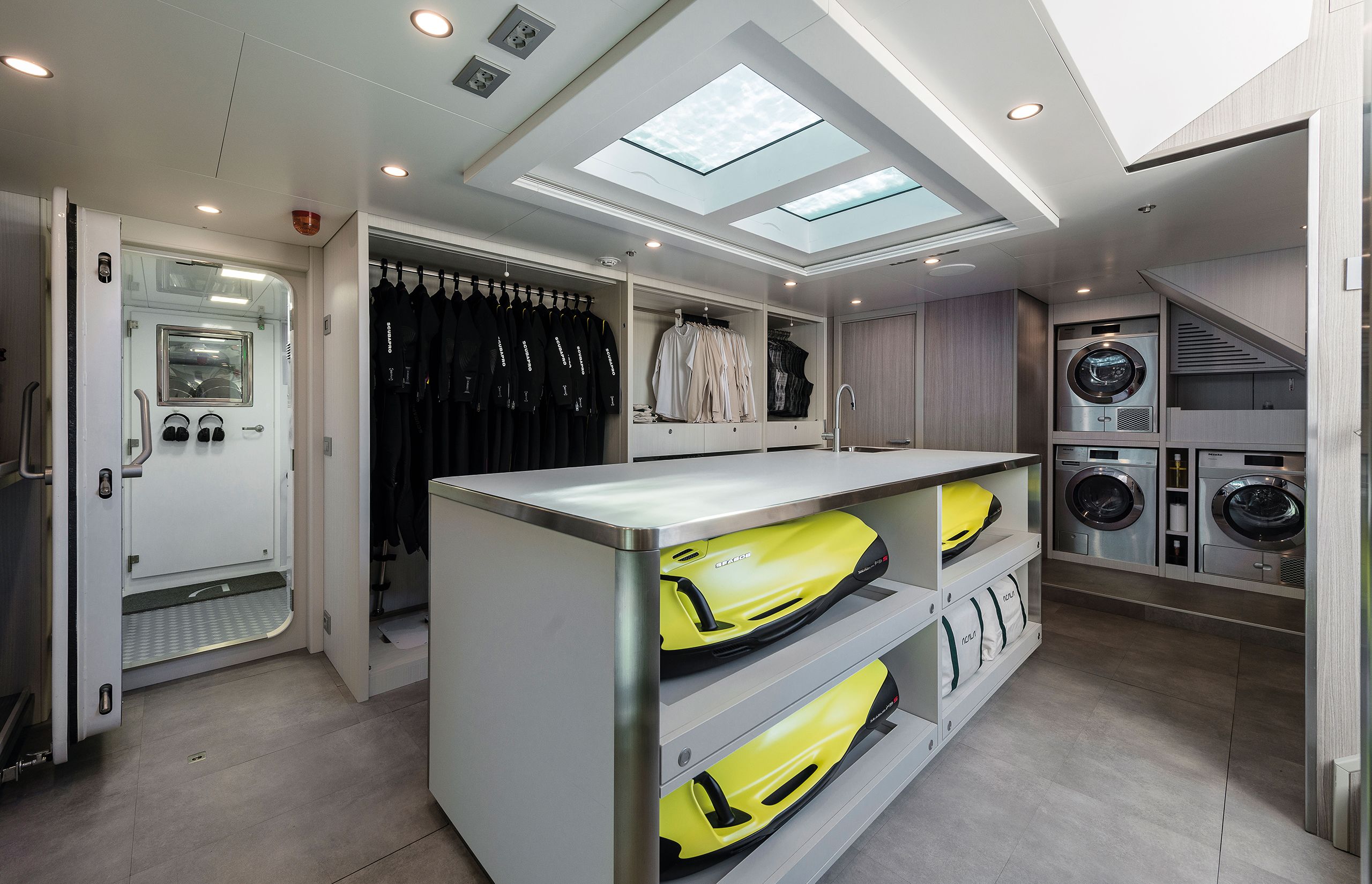
Decoratively, the brief was for a relaxed atmosphere, which Hamui translated into a natural, textural palette. Wood dominates, with aged ash for cabinets; wire-brushed oak for panelling, textured (for grip as well as feel) ash for flooring; aged eucalyptus for the master suite cabinetry and grey sucupira wood in guest cabins. “Most woods are naturally oil-finished to maintain breathability and aroma,” says Hamui. “Aniline dyed leathers that are warm and soft enhance hardware pulls and cabinet details.”
Sofas are upholstered in cashmere, rugs are hand-woven alpaca, while most of the furniture is designed by Hamui’s studio and built in Mexico or Italy. “Most cabinets have leather inserts in different nuances: beige, orange, grey, powder blue,” says Hamui. Corners are curved, finishes are matte, colours are muted, lighting indirect. It’s soft, calm and very cool.
Of particular interest is the felt substitute material, interspersed with wooden strips, that runs longitudinally on overheads. It gives a cocoon-like feeling, “but also it is highly absorbent, so it makes the inside very quiet,” says Hamui. “I’m always very careful with acoustics on my interiors, because they do play an important role in how you live in the space.”
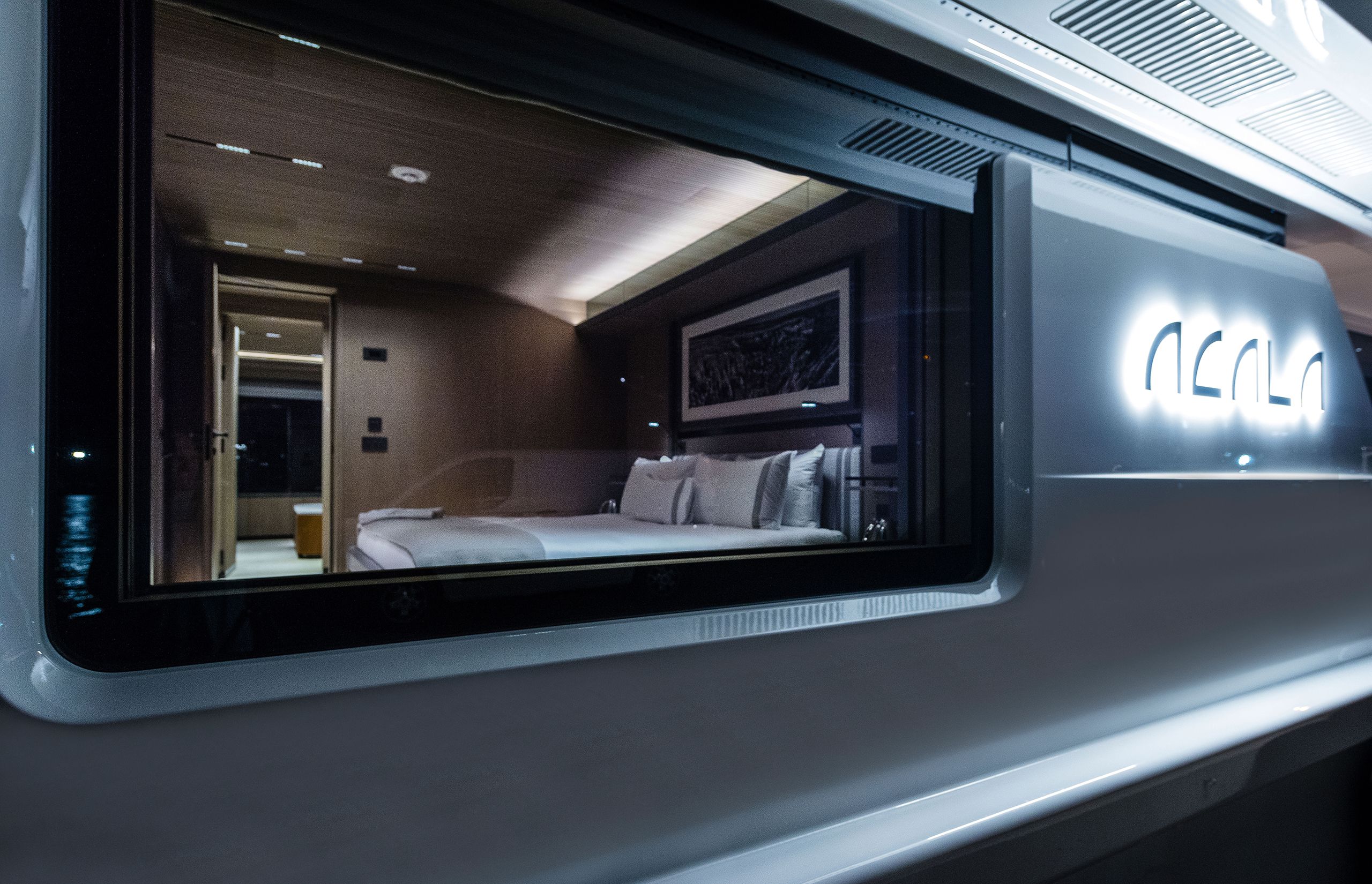
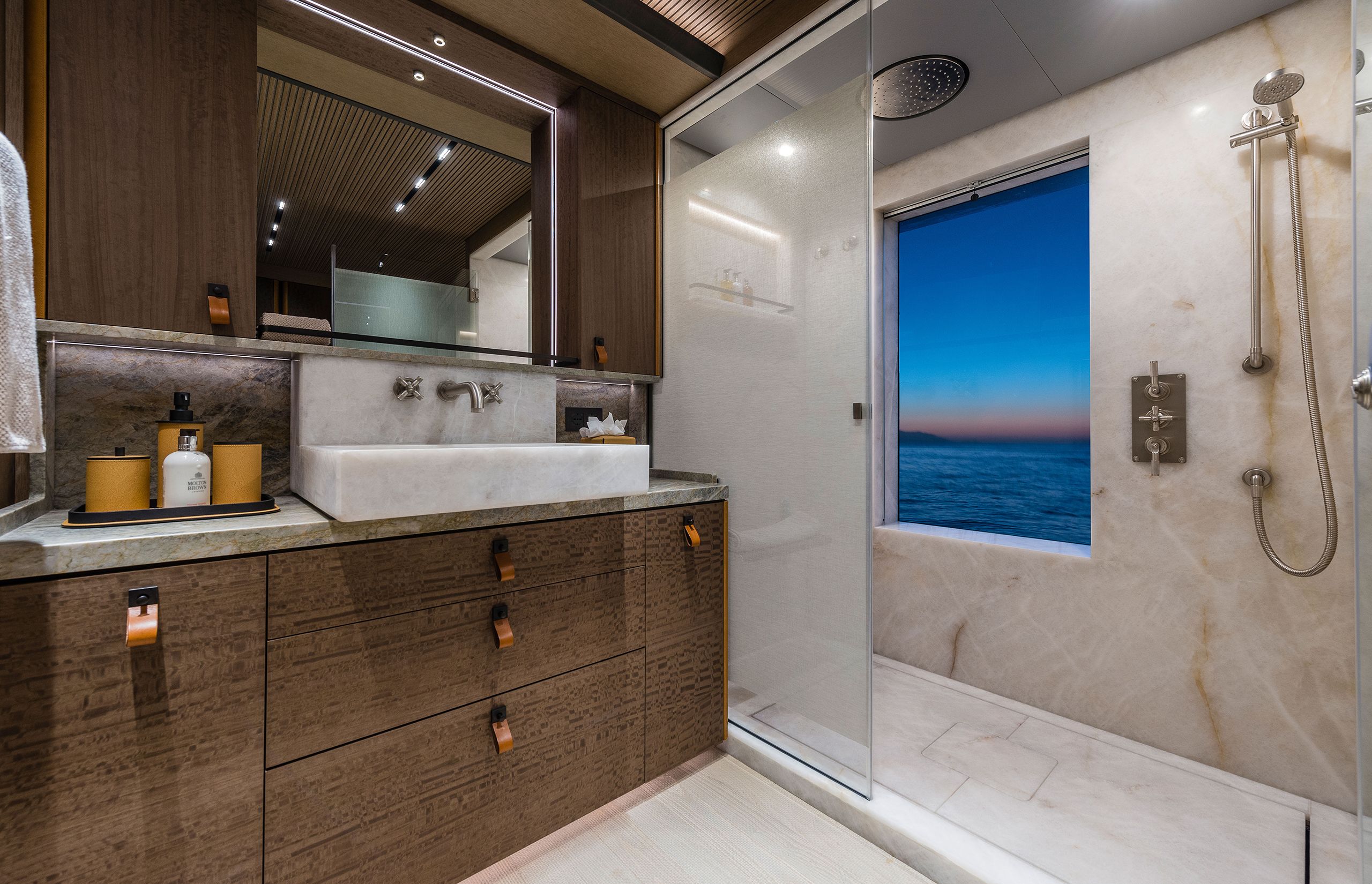
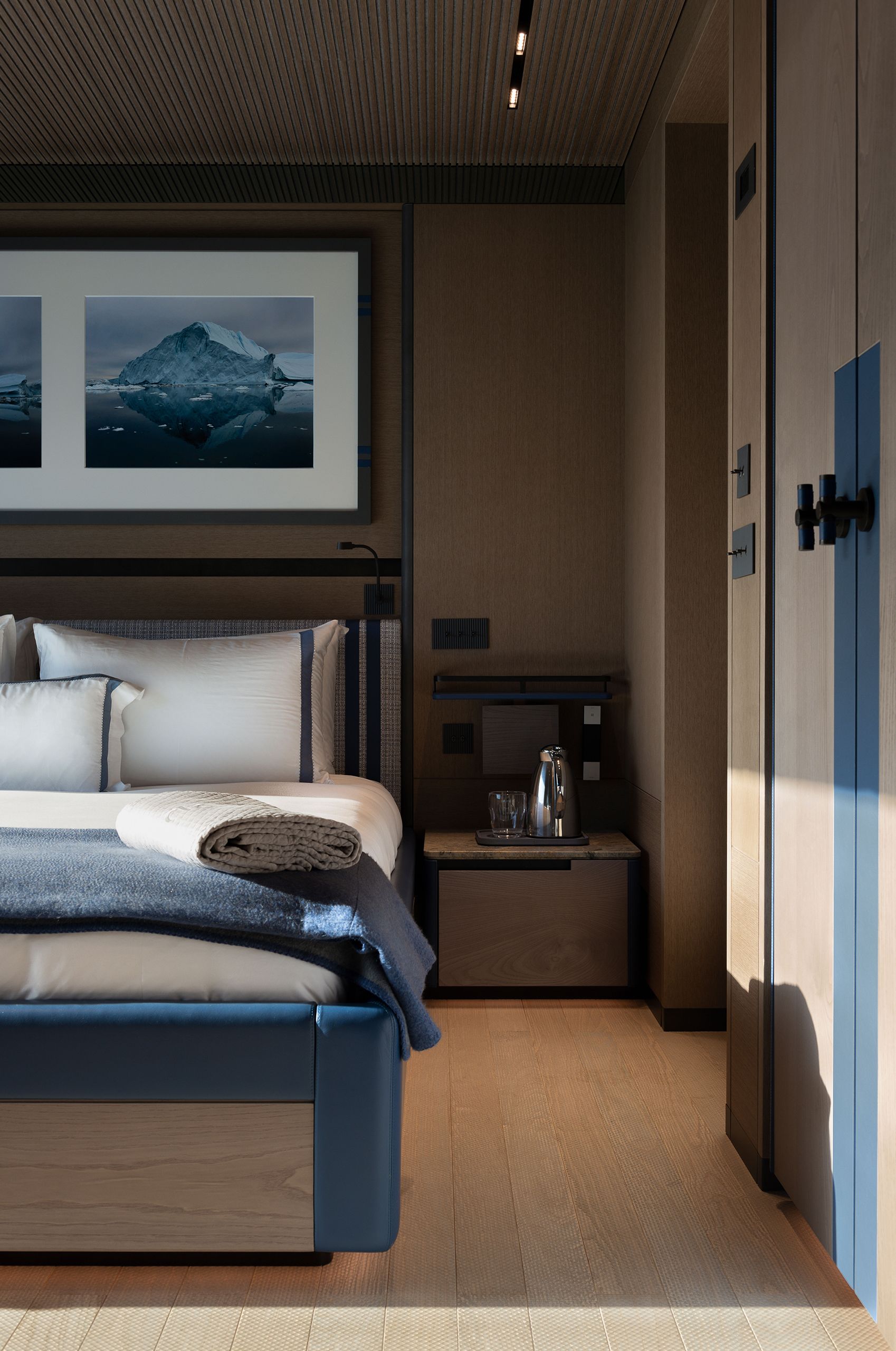
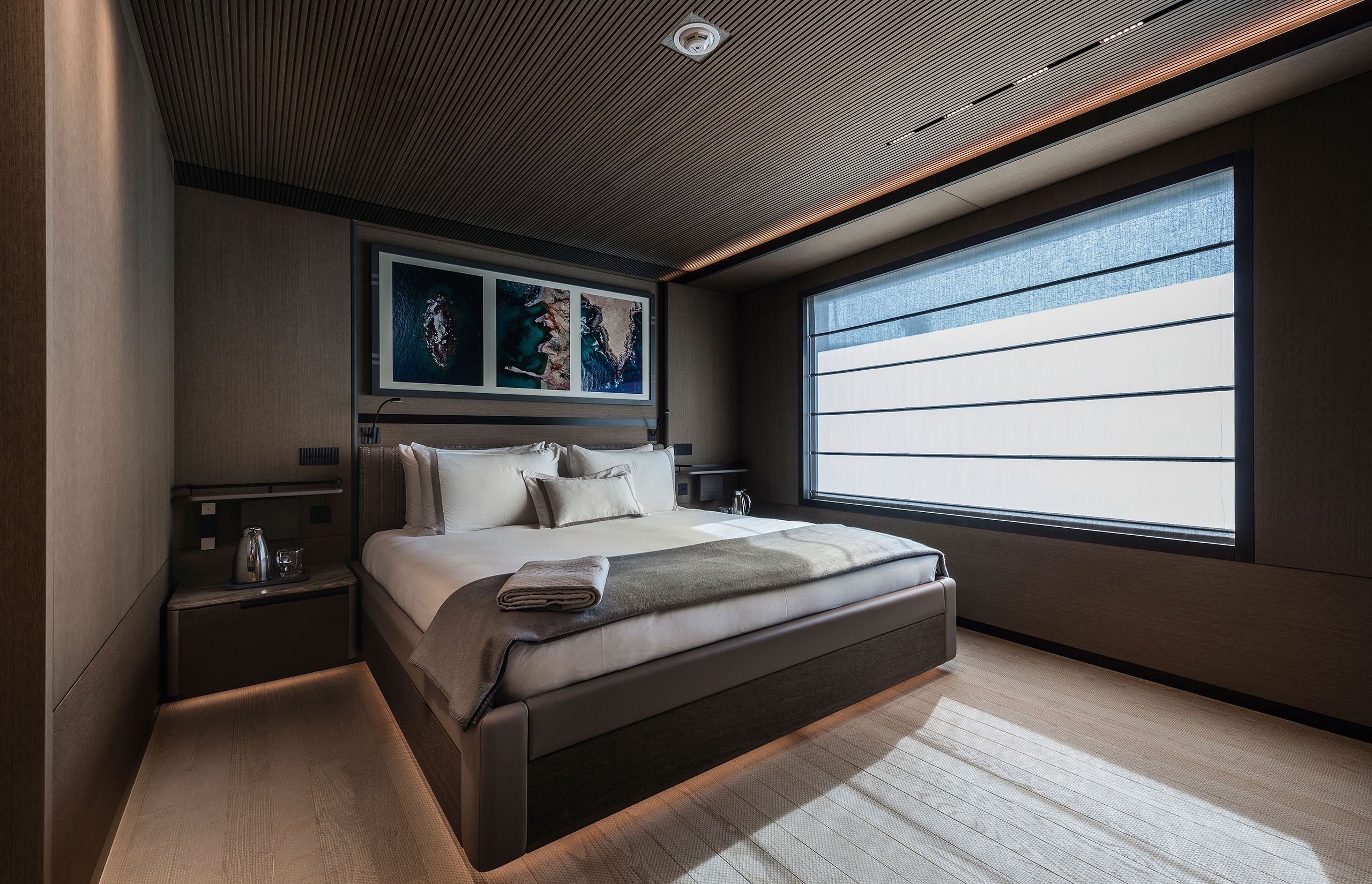
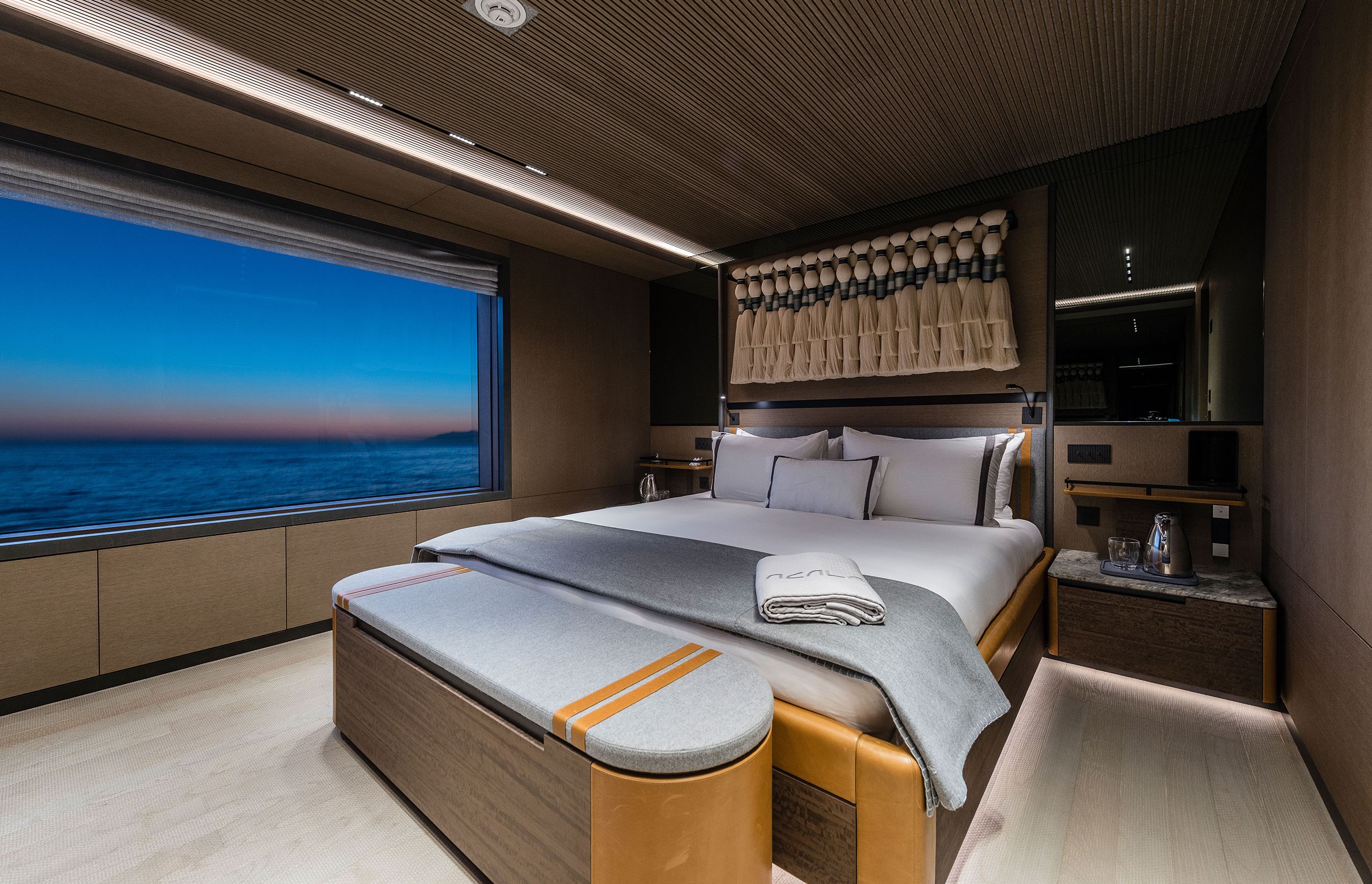

LEONARDO ANDREONI
LEONARDO ANDREONI

LEONARDO ANDREONI
LEONARDO ANDREONI

LEONARDO ANDREONI
LEONARDO ANDREONI

LEONARDO ANDREONI
LEONARDO ANDREONI

LEONARDO ANDREONI
LEONARDO ANDREONI
On the main deck, the owner requested that the modest master suite (top left), including a walk-in wardrobe-cum-bathroom (top right), be almost indistinguishable from the three guest cabins (bottom). There are two more guest cabins on the deck below
Crew have not been forgotten either. Freeing up main deck space for cabins allows for a massive crew mess and huge cabins, alongside a large galley on the lower deck, with good-sized pantries on both the main and upper decks, and a dumbwaiter that reaches all the way to the sundeck. “All of that was very, very intricate for a small boat,” says Hamui.
The equation seems to be working well for the yard. The popularity of the design, which was meant to be a one-off, means it plans to develop a 40-metre version with Bozzo. This will still pack on some great spaces, but with 80GT less volume. It’s a logical step: Acala may have the wisdom of many larger yachts poured into her, but a central plank of that is you have to know what you need, in order to know what you don’t.
First published in the January 2023 issue of BOAT International. Get this magazine sent straight to your door, or subscribe and never miss an issue.
A dumb waiter reaches up to the sundeck for easy entertaining
The main tender is stored forward on the upper deck
Wide passageways can act as balconies with the addition of a coffee table and chairs
The glass bottom of the pool forms skylights for the dive store below
Freeing up main deck space for guest cabins allows for a large crew mess and cabins lower down
SMALLER EXPLORERS
The mid-sized explorer yacht market is booming. Here are three of the most interesting new series launches
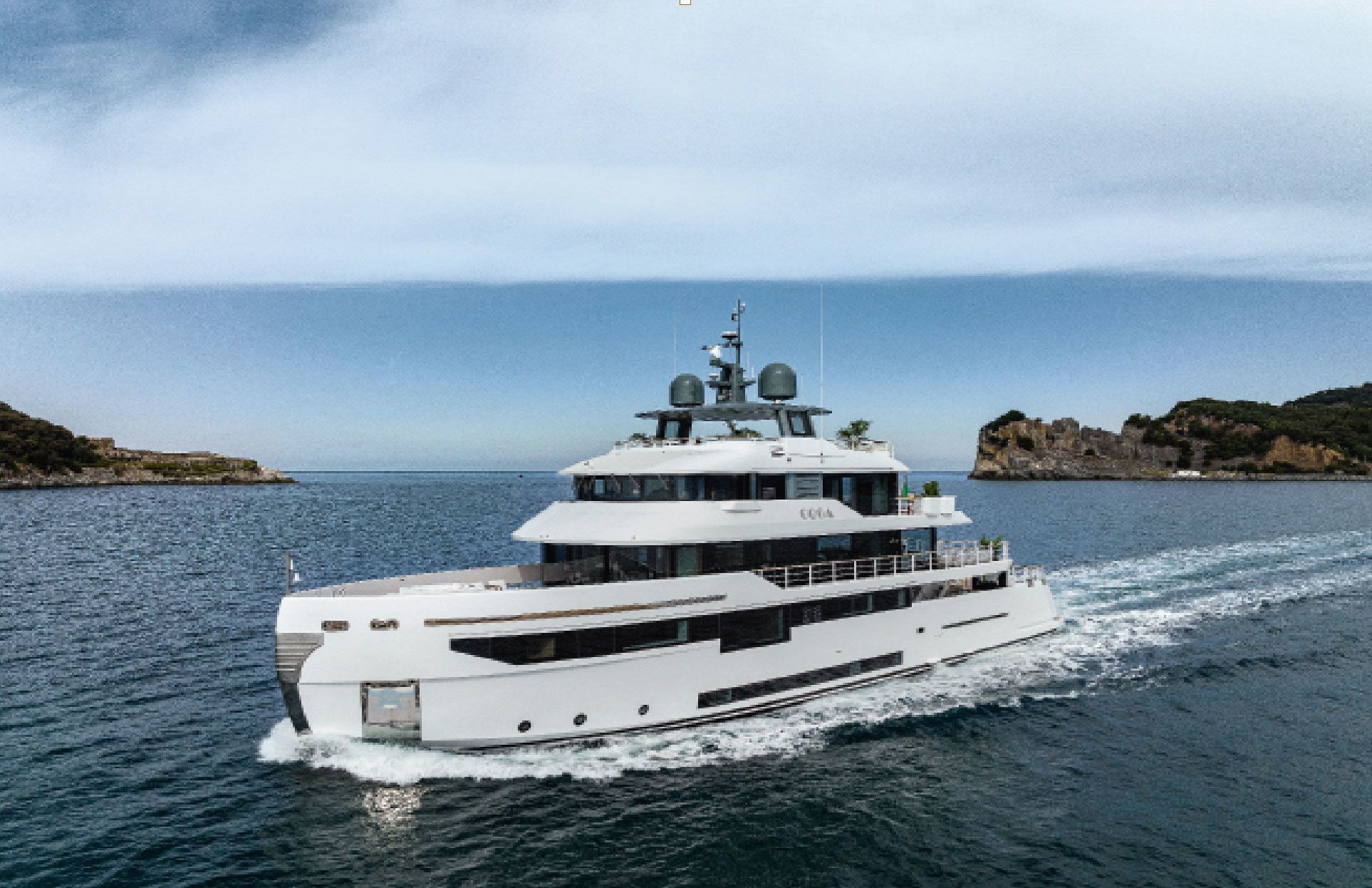
GOGA
37m, Benetti, 2022
Designers: Stefano Righini, Pierluigi Ausonio
A smaller steel-hulled explorer was out of Benetti’s comfort zone, but CEO Paolo Vitelli believed there was a market there for the B.Yond 37m design. He was vindicated before the first hull, Goga, was even delivered in July last year, with a further eight sold and buyers lined up for hulls 10 and 11. An 8.6m beam makes her almost a metre wider than Benetti’s 37m Motopanfilo model and she has a flexible electric hybrid system, with a range of 5,000 nautical miles at 10 knots. She packs lots of useful features into four decks, including seven guest cabins and a main deck garage for a 6.5m tender.
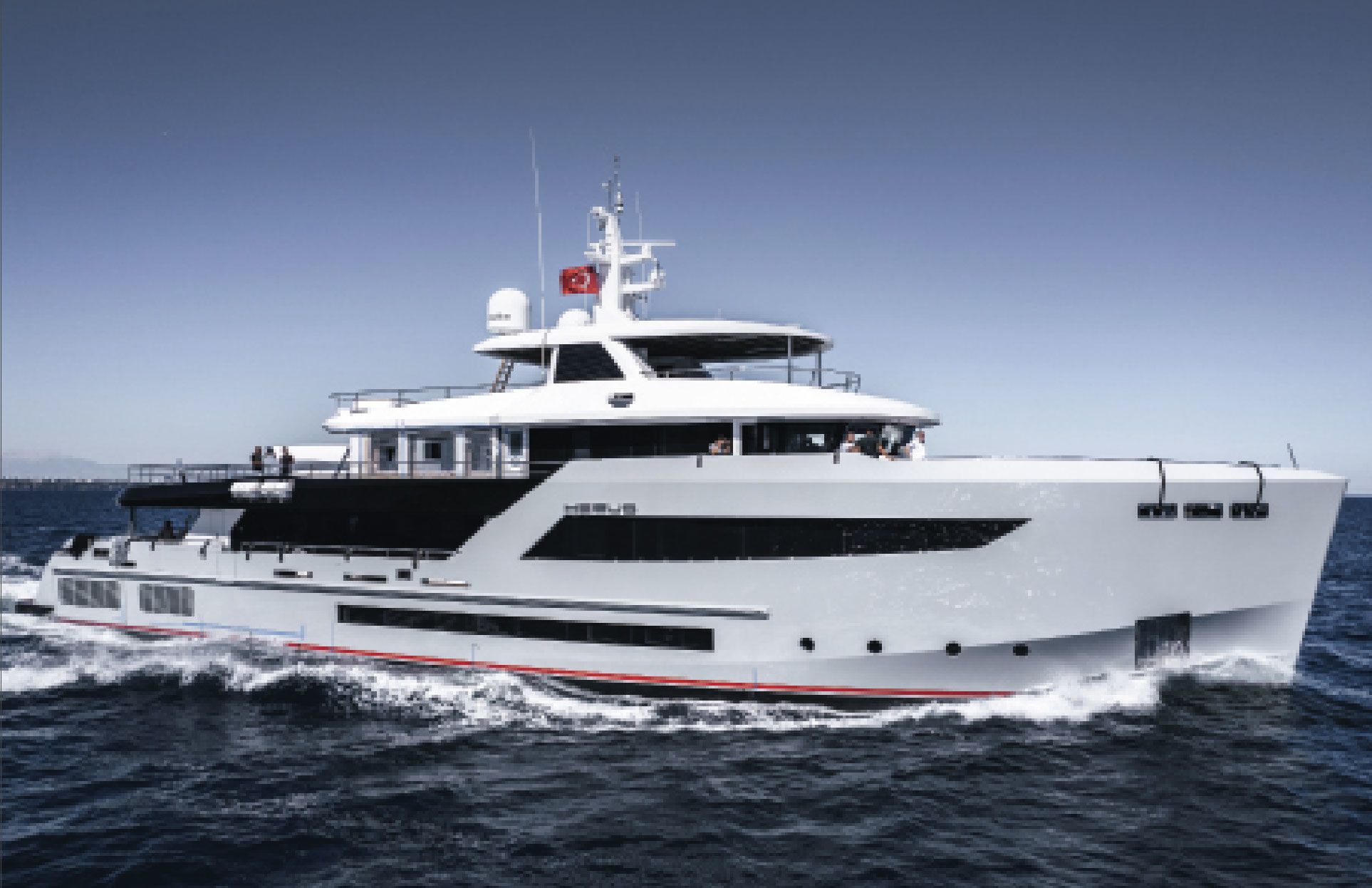
HEEUS
44.2m, Bering Yachts, 2022
Designers: Bering Yachts, Sabdes Yacht
This flagship of Turkish yard Bering Yachts is the first in a line of compact Bering 145 explorers capable of high-latitude cruising thanks to features such as an ice belt. She has a cruising range in excess of 5,000 nautical miles at 12 knots, as well as efficient hybrid propulsion. There’s a 25-square-metre garage for storing tenders and toys, plus a main deck owners’ cabin with huge windows.
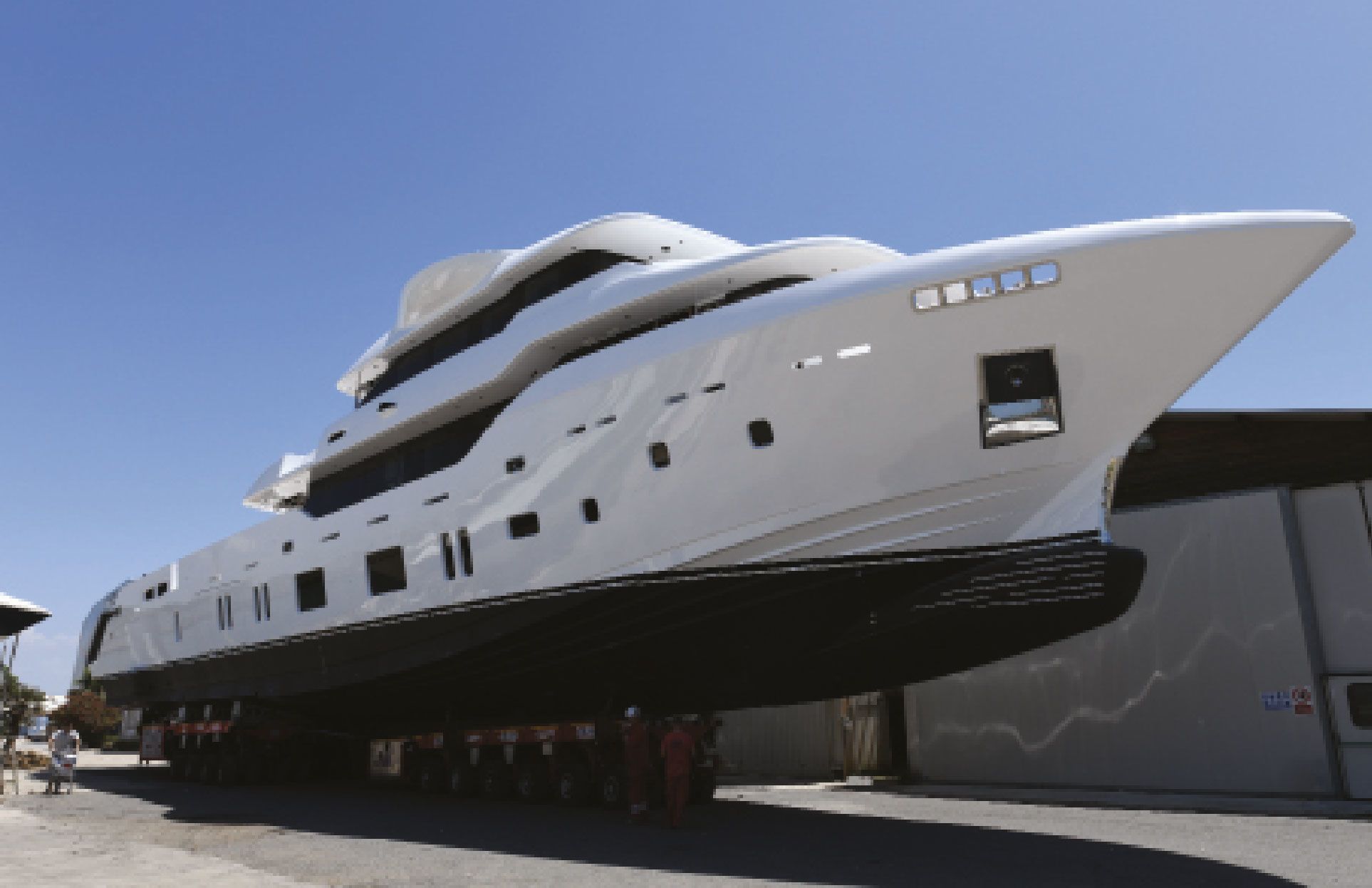
OCEANIC 143
43.45m, Canados, 2022
Designers: Arrabito Naval Architects, Michela Reverberi
The first superyacht-scale hull in Canados’s Oceanic line, this yacht is designed to balance explorer capability with speed: she offers a 6,000-nautical-mile range at 8.5 knots, with a top speed of 23 knots. The yacht’s twin-stepped hull has been designed to reduce friction and improve stability in rough seas. The Oceanic series ranges right down to an entry-level 23.7m Oceanic 76 model.

